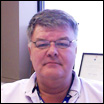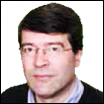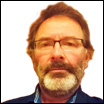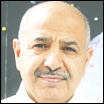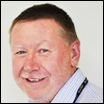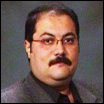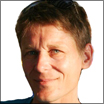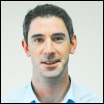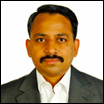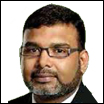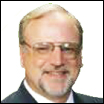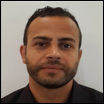Speaker's Abstract and Bio |
|
|
Campbell Brooke
Worldwide Director of Sales and Distribution
Trimble
Singapore
|
|
Bio
Campbell Brooke is the WW Geospatial Sales Director for Trimble. A professional Land Surveyor from NZ with 30 yrs experience in the Geospatial Industry
Abstract
The role of geospatial professionals are at the centre of an evolving ecosystem. In this presentation I will discuss how central geospatial information has become to our everyday life –a number of forces are driving this including smart devices, integration of technologies, apps for mobile devices, the need for workforce safety, and transparency of information
|
|
|
Carsten Roensdorf
Ordnance Survey International
UAE
|
|
Bio
Carsten Rönsdorf is Head of Advisory Services for Ordnance Survey International, a subsidiary of Britain’s National Mapping Agency. He manages the Dubai office and provides geospatial and strategic advice to government agencies across the Middle East, specialising in in open standards, data sharing, 3D and future cities.
A geodesist by training, Carsten has been at Ordnance Survey for more than 12 years and was previously responsible for developing and managing Ordnance Survey's core data asset, the National Geographic Database, managing the product engineering group and providing consultancy to geospatial data users in government and utilities in Great Britain. Being involved in geospatial 3D since 1996, he has been leading the standardisation of the Open Geospatial Consortium’s CityGML standard since 2007.
Abstract
Smart Dubai, geospatially smart that is
Dubai has stated an ambitious vision and plan to become the smartest city on the planet by 2017. This presentation examines what role geospatial technologies and data can play in an Smart City and what benefits can be achieved.
Geospatial technology has been extensively used by government agencies in Dubai, the private sector as well as individuals. How can this use be advanced to better utilise urban resources, make urban processes more efficient and increase the happiness citizens and visitors.
The future quality of life of city inhabitants will be determined by how well the resources in a city can be utilised and how individual's perceive the experience of being part of a city.
Data exchange and re-use, integration of sensor networks, big data, Building Information Models, 3D virtual reality and standards as well as the policies to create, manage and access data will be examined. The presentation will illustrate recent examples for projects and achievements in the UK in geospatial smart cities and give a number of practical suggestions for the geospatial information community in Dubai how a geospatially smarter Dubai can be achieved to provide tangible benefit to citizens and visitors.
|
|
|
Rico Richter
Hasso Plattner Institute, Potsdam Univ
|
|
Bio
Rico Richter is a research scientist with the computer graphics group of the Hasso Plattner Institute at the University of Potsdam, Germany. His research interests include processing and analysis techniques, scalable GPU-centric computing solutions as well as visualization and real-time rendering techniques for massive 3D point clouds.
|
| |
|
|
|
|
Prof. Georg Gartner
President
ICA
|
|
Bio
Georg Gartner is a Full Professor for Cartography at the Vienna University of Technology. He holds graduate qualifications in Geography and Cartography from the University of Vienna and received his Ph.D. and his Habilitation from the Vienna University of Technology. He was awarded a Fulbright grant to the USA and several research visiting fellowships. He is Dean for Academic Affairs for Geodesy and Geoinformation at Vienna University of Technology. He is Editor of the Book Series “Lecture Notes on Geoinformation and Cartography” by Springer and Editor of the "Journal on LBS" by Taylor & Francis. He serves currently as President of the International Cartographic Association.
|
|
|
Hannu Korpela
Sales Manager, Terrasolid
Finland
|
|
Bio
Hannu Korpela is an Msc. from Sanitary and Construction Faculty from Tampere University of Applied Sciences, Finland. Prior to joining Terrasolid, he worked for around 10 years in different engineering companies and also in building construction. He has been working with Terrasolid since 1991 as Marketing and Sales Manager, being part of the team that has been instrumental in the rapid growth of Terrasolid airborne and mobile mapping and LiDAR processing software.
Abstract
LiDAR in City Modelling - Different Approaches and Deliveries
Airborne and mobile LiDAR surveying are different methods to make city models for different purposes. The key-issues in both method are cheap data collection, automatic data processing, easiness to update models and a possibility to monitor the changes in the environment automatically. Airborne LiDAR suits the best to survey large areas whereas mobile LiDAR systems survey corridors and produce models of street and building facades. The quality of airborne models is around constant: the same point density and accuracy on the whole area. This information can also be used to fix the position of mobile LIDAR in cases, where control measurements are impossible. The point density is crucial to detect buildings and their details. The LoD level of buildings is 1 or 2. To vectorize mobile LiDAR data is an endless work and does not lead to good results. An advanced point coloring is a new solution to the problem. The method selects the best raster from images to color corresponding point, removes moving objects like cars, colorize thin objects like lamp poles and wires by intensity or uses mixed artificial colors to trees. In the process a careful data classification is essential. Luckily many of the processes, which are still manual, can be atomized to decrease manual work. Exact LoD3 level models as point clouds are easy to move between different systems. Besides using point clouds one can also produce hybrid models by vectorizing selected objects partly or completely. The presentation shows an example model done in 2014 in Helsinki city.
|
|
|
Dr. Hussein Harasheh
General Manager, Global Scan Technologies
UAE
|
|
Bio
Hussein Harahsheh is a Geo-information Scientist, currently General Manager at Global Scan Technologies in Dubai. He started his carrier, in 1986, as a research scientist and projects manager in the field of Remote Sensing and GIS at the Royal Jordanian Geographic Center, then he was appointed as assistant Professor at United Arab Emirates University. Harahsheh holds a diploma of Civil Engineering from France in 1986 and a PhD on “Remote Sensing and GIS applications” from Japan in 2000. Based on long experience of optical and radar image processing and analysis, his research interests focus on remote sensing and GIS applications for natural resources environment analysis and monitoring, with focus on Oil spill, Land use Land cover, agriculture and vegetation studies, and Land degradation and desertification. He participated in many regional and international research programs. He has several publications in international reviewed journal. He shared the publication of several remote sensing and GIS related books, and participated as speaker in many International Conferences.
Abstract
Geospatial for Environment
Geospatial Technology including Geographic information systems (GIS) and remote sensing is very important as source of information and tool for data analysis and visualization. This workshop presentation investigates how this technology is currently being used to better understand and address environmental problems, as well as manage and protect natural resources. Specific topics include: air pollution, climate change, biodiversity conservation, forest management, soils management and agriculture, natural hazards, water resources, environmental challenges in the urban environment, and alternative energy production. In this presentation we will present mainly two cases studies, one on land and another on water. We will show land degradation hazards and how these technologies helped to calculate efficiently and accurately the spatial extend of the phenomena of desertification. In marine side we will talk about the use of satellite imagery to detect and monitor the oil spill, which is a major environmental pollution.
|
|
|
Prof. Dr. Josef Strobl
University of Salzburg
Austria
|
|
Bio
Prof. Josef Strobl is an academic teacher and researcher leading the Interfaculty Department of Geoinformatics, University of Salzburg; and as a full member of the Austrian Academy of Sciences is heading its commission for Geographic Information Science. He holds degrees in Geography from Vienna University and has been teaching Geoinformatics and related subjects at universities worldwide since 1985. Current research is focused on spatial analysis, GIS and RS methodology and applications, distributed GIS on the Internet (Spatial Data Infrastructures) and dynamic process modelling. As chair of the UNIGIS distance learning network and as (editorial) board member for a number of publications, conferences and organisations, Josef Strobl is contributing to the education of future generations of GIS professionals.
Abstract
No Objection Certificate (NOC)
No Objection Certificates (NOCs) are extremely important and present many challenges given the significant amount of on-going and planned development in Abu Dhabi and across the Emirate, and as such, traditional project management approach may be slightly insufficient as we need to go beyond the mere objective of meeting the project schedule “getting the job done” to integrating the business aspect within the project plan and get the focus to be “getting the job done to best fulfil the business objectives of the organization and/or Stakeholders”
|
|
|
Michael Zarzeczny
Sales Manager, Europe, Middle East and Russia, Optech, Canada
|
|
|
|
|
Bio
Michael Zarzeczny is Optech’s Sales Manager for Europe, Middle East, and Russia. He is responsible for all airborne, mobile-mapping, terrestrial and bathymetry products. Prior to Optech he was at IBM Canada. Michael has a Bachelor’s Degree from the University of Western Ontario and a Double Graduate Diploma in Management from McGill University. He recently completed an Executive Education program at Harvard Business School.
Abstract
Mobile Mapping for Road Surface Analysis
This mobile mapping project was undertaken to aid in the process of road surface analysis & for purposes of expediting roadway maintenance in Queensland, Australia. Queensland’s very high precipitation levels and extreme weather events such as cyclones cause high levels of erosion necessitating speedy repair. Rapid collection of mobile data allows individuals to more effectively ascertain information about road conditions and document changes to increase the efficiency of road repair. The collect in Queensland presented many challenges, the greatest being GPS outages for extended periods of time. Collection of data was undertaken with the M1 Lynx Mobile Mapper, collecting up to 1 million points a second of highly accurate 3D point clouds.
|
|
|
Martin Holt
Regional Sales Director - Northern Europe & Middle East
Airbus Defence & Space Ltd
|
|
|
Bio
Martin Holt works for Airbus Defence and Space and is the Regional Sales Director for Northern Europe & Middle East. He has worked extensively in the Middle East since 1976, originally working on the first aerial survey of Qatar as a field surveyor, through to Project Management of an airborne survey in Oman to design new pipeline routes. He previously worked for Marconi Communications before joining Airbus Defence & Space Ltd. He heads a team of 8 specialists who offer data and solutions into markets such as Defence, Public Safety, Government Hosting, Land Administration and Oil and Gas.
Abstract
Remote Sensing is a process that can be used to generate accurate information, both current and historical and is key for decision makers to base their forward strategy and chosen path. Satellite and aerial imagery provide that access, both in its optical and radar forms, with its flexibility to not only provide images, but also a large array of derived products, such as terrain models, land use classification, change detection to name only a very few. With any point on Earth covered at least once a day, Airbus Defence and Space provides unrivalled access to the most comprehensive range of commercial Earth observation data available today. Our data products comprise imagery acquired by the Pléiades and SPOT constellation, TerraSAR-X, TanDEM-X and from partner satellites such as FORMOSAT-2 and DEIMOS-1.
|
| |
|
|
Dr. Mohamed Mostafa
President, Navmatica ME
UAE
|
|
|
|
|
|
Abstract
End-To-End Precision Mobile Mapping for 3D Topo Mapping Applications
This paper presents the detailed workflow of a large mobile mapping project held in 2014 for 3D High Precision Mapping purposes. The acquired data includes GNSS/Inertial data for Georeferencing purposes, 360 degree panoramic imagery, 4 high resolution still digital camera imagery and two high end laser scanning data. This presentation also examines the multi-faceted technological and organizational challenges associated with completing a project with high accuracy requirements in an urban centre with many challenges such as high-rise buildings, traffic congestion and heavy construction.
During the course of this project, Navmatica conducted a detailed geometric accuracy analysis focused on a number of parameters including:
- • GNSS/Inertial achievable accuracy in crowded urban centres, especially in the presence of high rise buildings, tunnels and bridges
- • Camera/IMU Boresight calibration accuracy and calibration stability
- • Laser/IMU Boresight Calibration accuracy and calibration stability
- • Accuracy of final 3D Point Cloud after Registration of multiple scenes
- • Overall system accuracy in different urban cases
- • Automated processing for feature extraction of features from laser and image sequences
- • Quality Control procedure and its effect on final mapping accuracy
|
|
|
Bio
Hans Viehmann joined ORACLE in 1994 and in his first role he came across GIS Systems and Spatial Databases for the first time. He specialized in this subject and after various positions in Presales and Presales Management he joined the Product Management Team in 2011. Since then he represents the ORACLE Spatial and Graph Development Team in Europe, Middle East and Africa and is a regular speaker at conferences and symposia in the region. He also serves on the Advisory Board of InGeoForum, Germany.
Abstract
With the cost of 3D data acquisition constantly falling, many city modeling use cases based on the availability of 3D data have become affordable in recent years. This trend gives rise to very large volumes of data being collected which must be managed, processed and analyzed in conjunction with both the associated metadata as well as complementary data such as raster imagery.
Increasingly, geospatial databases are being used for these purposes, which leverage the scalability and information lifecycle management capabilities of standard databases while at the same time allowing the integrated database logic to specifically store and analyze point clouds, TINs, solids, 3D vector data and geo-referenced raster data sets. This enables the derivation of more compact, generalized 3D models from laser scanning data without unnecessary data movement or transformation. The results can then be cast into semantically rich data models which in turn allow easy data visualization, analysis, including simulation, or dissemination through standards such as CityGML or KML.
In this paper a solution for the end-to-end processing, storage and analysis of point cloud data is presented, which uses an ORACLE database with the additional functionality of the Spatial and Graph option. It touches on topics such as city model development, city model change detection and maintenance as well as the associated standards, all of which will be discussed further in the following presentations of the workshop.
|
| |
Lutz Ross
virtualcitySYSTEMS
UAE
|
|
|
Bio
Dr.-Ing. Lutz Ross is Head of System Integration at virtualcitySYSTEMS GmbH, Germany. He joined the company in 2010 and is responsible for project acquisition, project management, and acts as a product manager for virtualcitySYSTEMS 3D Spatial Data Infrastructure (SDI) solution virtualcitySUITE. He worked as research assistant at the Hasso-Plattner-Institute Potsdam, Technical University Berlin and University of British Columbia and received his PhD degree from the Technical University of Berlin in 2010.
Abstract
Case Studies - From City Model Development to Simulation
Over the last decade many municipalities and countries build up sophisticated 3D City Models that are used for many different purposes in many different system environments. The presentation will show examples of 3D City Models and their usage from several European cities as well as latest research results showing the use of City Models for complex numerical simulations. It will highlight the importance of Open Standards and Interfaces for City Model management and storage and will demonstrate how interoperability between different system solutions can be achieved by using CityGML as core data model for 3D City Models.
|
| |
| |
|
|
Dr. Prashanth Marpu
Assistant Professor
Chemical & Environmental Engineering, Masdar Institute, UAE
|
|
|
|
|
|
Bio
Dr. Prashanth Marpuis an assistant professor in the Water and Environmental Engineering Program at Masdar Institute. His specialization is in image processing, data mining, machine learning, remote sensing and GIS. Prior to joining Masdar Institute, Dr. Marpu was a researcher at the University of Iceland, Reykjavik, Iceland. Before that he was a Marie Curie Fellow at the University of Pavia, Italy working on developing advanced methods for hyperspectral data analysis. Dr. Marpu holds a PhD from Freiberg University of Mining and Technology, Freiberg Germany and MSc in Wireless Engineering from the Technical University of Denmark, KongensLyngby, Denmark. He has developed approaches for automatic change detection in multi-temporal remote sensing images, spectral-spatial classification of data and hyperspectral image processing.
Abstract
The objective of this tutorial is to provide students with an understanding of the remote sensing and applications for mapping and monitoring the natural environment.It covers a range of remote sensing tools and techniques used to address environmental issues at local, regional and global scales. Technical topics include multi-spectral and multi-temporal analysis, supervised and unsupervised classification, and change detection.
- • Introduction on Remote Sensing and Electromagnetic radiation
- • Satellites and Sensors
- • Satellite image processing
|
|
Rami Hazime
Digital Globe
UAE
|
|
|
|
|
|
Bio
Rami Hazime joined DigitalGlobe (NYSE:DGI) in 2014 as Senior Manager for the Middle East region. Prior to DigitalGlobe, Mr. Hazime has held senior management positions at AVEVA and previous to this Fugro Maps for Saudi Arabia. He has over 15 years experience in the geospatial industry and has extensive knowledge in remote sensing, photogrammetry, bathymetry, LiDAR and aerial surveys. Mr. Hazime holds a degree in Computer Science from the American University of Beirut
Abstract
Mapping, Monitoring & Analysis - addressing key issues for Internal
Security
Over the last decade, significant progress has been made in developing and launching satellites suited for earth observation, with instruments in both the optical/infrared and microwave regions of the spectra. Commercial availability of optical very high spatial resolution spaceborne imagery began more than 10 years ago with the launch of IKONOS and QuickBird, which led to an increasing interest in satellite data for mapping and precise location-based service applications. Since then, a large amount of data has been acquired, including images from newer and more complex platforms such as WorldView-1, WorldView-2, GeoEye-1, and the more recently WorldView-3. Currently, the potential global capacity of very high spatial resolution imaging satellites is greater than 1.8 billion square kilometers per year, which corresponds to more than 12 times the land surface area of the earth. This capacity could potentially increase to more than 2.4 billion square kilometers per year (about 16 times the land surface area of the earth) in the near future.
Despite the vast amounts of data collected, commercial imagery providers are finding that imagery plays a foundational part to a customersâ?T needs. Users in many domains require information or information-related services that are focused, concise, reliable, timely and provided in formats specific to a userâ?Ts own activities.
The commercial remote sensing industry is on the verge of an information revolution, as new satellites are developed that offer increased resolution, improved accuracies, greater spectral diversity and faster access to imagery and derived information. These trends are further aided by technology improvements in processing speeds, cloud computing, delivery mechanisms, and new information extraction techniques that will make the imagery and derived information more economical and accessible. This presentation will highlight key developments in the satellite derived earth observation industry and showcase advanced capabilities that enable both private and public service users to understand, optimize and manage their Internal security issues including change detection, 3d mapping, coastal and border surveillance, people and asset monitoring and emergency response and disaster management.
|
| |
Richard Budden
Business Development Manager
Transportation and Infrastructure
Esri
Dubai
|
|
|
|
|
|
Bio
Richard studied at the University of Reading in the UK and in 2001 he received a Bachelor of Science in Human and Physical Geography.In 2002 he joined Atkins, the UK design and engineering firm, providing GIS consultancy and advice to clients including the London Borough of Islington and Crossrail, where he achieved the UK Association for Geographic Information Award for innovation and best practice in the private sector.
In 2011 Richard relocated to the Gulf to lead the Atkins Middle East geospatial team, working on complex multidisciplinary projects for clients including the UAE Ministry of Public Works, Kuwait Municipality, Abu Dhabi Urban Planning Counciland the Qatar Ministry of Municipality and Urban Planning. Richard has engaged with government clients and offered strategic advice that has contributed towards the development and implementation ofnational visions and smart cities.
In 2014, Richard joined Esri as Business Development Manager for transportation and infrastructure for the West Asia, Middle East and Africa regions. He is based in Dubai, UAE.
|
|
|
Saif ALSAIFI
Marketing and Sales Executive, GRINTEC GmbH
Austria
|
|
|
|
|
|
Abstract
Augmented Reality GIS – The new way of the (mobile) GIS use
Augmented Reality is now in game consoles or in industry a common and practical technology. For many years, GRINTEC is engaged in the use of augmented reality technology in the context of GIS for (energy) operators, infrastructure and the public sector. GRINTEC has developed a lot of experience in various research projects. As part of the presentation GRINTEC would like to explain and present its experience with augmented reality (AR) and mobile GIS. We lay particular emphasis on applications requiring high accuracy considering the position and height information of the GIS data. We show the benefits of this technology and where the current challenges lie in the use of AR technologies.
|
|
|
Shafik Jiwani
Rolta
Middle East
Dubai
|
|
|
Bio
Shafik Jiwani is a veteran in GIS with over twenty years of experience and currently holds the position of Executive Vice President of Rolta Middle East. based in Dubai. Under Shafik’s leadership, Rolta has helped organisations around the world integratespatial technology into all facets of their businesses. In this long professional carrier Shafik has won numerous awards in the field of geospatial technology.
Shafik played an important role in the implementation of the world’s first societal GIS in Qatar in the 1990’s, and was bornand raised in Tanzania.
|
|
|
Thomas Gaisecker
Senior Manager, International Sales, RIEGL Laser Measurement Systems GmbH
Austria
|
|
|
Bio
Thomas Gaisecker is the Senior Manager, International Sales at RIEGL Laser Measurement Systems GmbH. He studies on geography with focus on geoinformatics at University of Salzburg from 1988 to 1995. He has been with RIEGL Laser Measurement Systems GmbH since 2003 as an expert for Terrestrial Laser Scanning and applications in mining, as well as UAS-based laser scanning.
Abstract
From risk to routine: How to enhance safety standards for industrial inspection by remotely piloted aerial surveying
Public infrastructure and technical installations are subject to regular inspections, both to ensure technical security and personnel safety. In order to improve the inspection workflow with respect to efficiency and thus provide a cost-reducing solution, we propose a UAS (unmanned aircraft system) based surveillance method, relying on state-of-the-art sensor technology fully integrated into a specifically developed remotely piloted aerial surveying platform.
The core sensor system consists of a survey-grade laser scanner, a GNSS receiver, a professional IMU sensor, and calibrated high-resolution cameras.
We discuss the potential of UAS-based laser scanning for several applications, namely powerline and railway monitoring, and powerplant and offshore oil rig inspection. While the first two display typical situations of corridor mapping, based on a once established linear flight plan, the latter are examples for surveillance of complex structures. In both cases, specific problems occur upon data acquisition:
the capability of ground-based or high-altitude airborne survey to detect fine features such as powerlines is limited, yet the low level flight of the unmanned aircraft allows to fully exploit the capacity of the laser scanner: thanks to the large field of view and multiple target capability it is possible to carry out reliable monitoring, to penetrate vegetation and to extract fine features of interest almost automatically out of a remarkably dense point cloud.
The challenges in inspecting industrial installations are their high degree of complexity and obstructed accessibility. Making use of a remotely piloted aircraft, areas hidden from a stationary (and mostly ground-based) perspective can now be thoroughly explored. An expansion of the sensor system for such missions is envisaged: the combination with thermal imagery or chemical sensors could further enhance the information output of routine surveying. Comparison of separately acquired datasets and experimental data from combined sensor integration on unmanned aircraft are discussed.
|
|
|
Vivek Kale
Solutions Director
Bentley Systems
|
|
|
Bio
As a qualified Architect and Urban Designer, Vivek Kale practiced four years of Urban Design in Middle East with Parsons HBA, including “Structure Plan For Dubai Emirate – 2012” for the Dubai Municipality, before joining Bentley Systems in 1998. He was the founder member of the regional MicroStation User Group, and a technology enthusiast for the ‘built environment’ for the past 17 years. He has been evangelizing Bentley’s BIM (Building Information Modeling) applications for 10 years. Now working from Dubai and covering the region, his responsibilities include educating, proposing and deploying Bentley’s solutions that add values to Government, Designers, consultants Contractors and Owner operators.
Abstract
3D City GIS for Sustaining City Infrastructure
Cities around the world challenges of creating sustainable, intelligent infrastructure. A 3D City GIS can help address many of these challenges. Bentley is committed to developing and leading the transition from traditional 2D representations of infrastructure to 3D representations. This additional dimension can increase the value of data, improve decision-making capabilities, and enable more effective communications about complex situations.
|
|
|
Dr Zaffar Sadiq Mohamed-Ghouse
Lead Consultant-Spatial Information & Practice Leader - Spatial Database Management & Mapping,
SKM
Australiabr
|
|
|
Bio
Dr Zaffar Sadiq Mohamed-Ghouse is a Principal Consultant at GHD, Australia, global engineering and project delivery firm. He has 17 years of experience in consulting studies, design, development and management of spatial databases, review data framework policies, and technology including GIS applications development. Zaffar has led successfully multi-million dollar projects in Australia for Government and Industry. He holds a pivotal role as an advisor to various National and International spatial organisations. Zaffar has published 40 research papers. He represents Australia on the ISO Technical Committee for Geoinformation and Geomatics and is member of the adhoc Standards group on BIM and GIS integration. He is also a member of several boards and technical committees at National and International level. Zaffar is a recipient of the “Young Professional Award” presented by the Surveying Spatial Sciences Institute, Australia. He holds an Honorary Senior Fellow appointment at the Department of Infrastructure Engineering, The University of Melbourne, Australia; Advisor for Industry Liaison for the Australian Cooperative Research Centre for Spatial Information; Visiting Expert and University of Technology Malaysia. Currently, he is the Chairman of the Surveying Spatial Sciences Institute in Victoria and a Board Member at national level. He is a Member of the Council at the International Society of Digital Earth and International Journal’s Editorial Boards.
Abstract
Spatial Enablement of BIM
The Building Information Modeling (BIM) has made a paradigm shift in construction standards. From a geospatial perspective the objects stored in BIM need to be topologically structured so that spatial analysis can be performed from a asset management perspective. Spatial analysis means applying Max Egenofer’s 9 intersection model to query spatial objects. Often the BIM implementation are more towards a 3D representation of the objects in addition to 3D visualisation. The presentation will discuss an overview of the work carried out internationally on spatially enabling BIM which is at an early research stage. Once this is established, application queries such as: Show me the shortest evacuation route for a high-rise building in case of a fire incident?, how many litres of paint is required to paint the graffiti in the building basement? What is the optimal way to lay an internet cable with minimal disruption to my building assets? and many more spatial queries can be addressed by spatially enabling BIM.
|
|
|
Mark E. Reichardt
President & CEO
Open Geospatial Consortium (OGC)
USA
|
|
|
Bio
Mr. Reichardt is President and CEO of the Open Geospatial Consortium (OGC), an international voluntary consensus standards organization comprised of over 470 industry, government, academic, research and NGO organizations. The OGC mission is devoted to facilitating a global forum and social process for advancing open standards and best practices to make it easier to share, manage, access, integrate and apply geospatial information for improved decision making. OGC standards are implemented in technologies and communities of use worldwide to enable interoperability across different processing platforms, applications, systems, networks, organizations and jurisdictions.
Mr. Reichardt is an accomplished cartographer, having held a variety of map production and technology innovation positions with the US Federal Government from 1980-2000. In 1998, Mr. Reichardt was selected to work on Vice President Gore’s National Partnership for Reinventing Government program, to implement a series of local, state and federal pilot initiatives to demonstrate the power of digital maps / geospatial information and tools to improve program coordination across levels of government. He also served under assignment to the US Federal Geographic Data Committee (FGDC) to implement an international program of awareness building and training to encourage the implementation of local, regional and national Spatial Data Infrastructures (SDIs).
Mr. Reichardt currently holds appointments to the OGC Board of Directors, the Global Spatial Data Infrastructure (GSDI) Association Board of Directors, The National Academy of Science Mapping Science Committee, and the BuildingSmart Alliance Board of Direction. From 2011 to 2013, Mr. Reichardt was appointed by the Secretary of the Interior to serve on the US National Geospatial Advisory Committee, a Federal Advisory Committee comprised of industry, government and academic professionals to provide advice and recommendations to the US Government on geospatial management programs and advancement of the US NSDI.
Standards Interoperability Workshop
This workshop will provide attendees with an overview of the open standards framework used globally to support geospatial and location information sharing across systems, applications, networks and the mobile environment. Open standards are becoming increasingly important to not only to assure ease of information sharing, but to support rapid mobilization of new capabilities, to reduce IT lifecycle costs, and to minimize effort. The workshop will also provide insight into standards work to advance standards and best practices for smart cities, mobile applications, indoor location and navigation. Examples of implementations from around the world will be featured.
|
|
|
Motaz Mostafa
Regional Sales Manager
Trimble Geospatial
|
|
|
Bio
Motaz Mostafa is a regional sales manager with Trimble Geospatial. He has been with Trimble for 4 years and has 10 years’ experience as a land surveyor in the US Army, private sector, and government contracting. Motaz is a graduate of the National Geospatial Intelligence Agency with the Army Corp of Engineers and a licensed Professional Land Surveyor in the state of California.
|
|
|
Hadeel Akram Fadda
Dubai Municipality
UAE
|
|
|
Bio
Mrs . Hadeel Akram Fadda is a bilingual Architectural Engineer with over 16 years of experience
joining Building Permit Department in Dubai Municipality as a Principal Architectural Design Engineer Since 2005
Master’s degree in “construction project management”
Researcher about BIM applications
|
| |
| |
